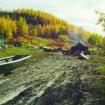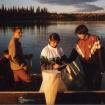Poplar
Common Name:
balsam poplar, cottonwood
Gwichya Gwich'in Name:
t'oo
Teetł’it Gwich’in Name::
t'oo
Latin Name:
Populus balsamifera
As medicine
The buds, which are very sticky, are collected in the spring before they open and then boiled. Drinking the tea relieves cold symptoms. The resin which collects on the side of a pot can be used for cuts. The sticky buds can be applied to a sore to aid healing. Long ago, people burned the bark of poplar and then mixed the ashes into dog food. This helped control worms and keep dogs’ fur in good condition.
Source: Andre, Alestine and Alan Fehr, Gwich'in Ethnobotany, 2nd ed. (2002)
Poplar buds are used to make a salve or a steam to treat nasal and chest congestion caused by colds. The best time to gather the sticky buds is in the springtime. These can be frozen or dried for future use. The leaves, like other leaves, are chewed and applied on insect stings and bites.
Source: Andre, Alestine, Nant'aih nakwits'inahtsìh (The Land Gives Us Strength) (2006)
As fuel
Poplar driftwood found along the Mackenzie River is good for drying fish in a smokehouse because it burns longer than other types of wood. Poplar is also good for smoking moose hide as part of the tanning process.
As bait
Victor Stewart (GEKP) said that poplar, like birch and willows, can be used for baiting beaver traps.
As tools
Poplar wood is soft and was used to make snow shovels.
As toys
Toys such as scows, boats and boats with kickers were made from poplar as the wood is soft and easily carved.
Source: Andre, Alestine and Alan Fehr, Gwich'in Ethnobotany, 2nd ed. (2002)





